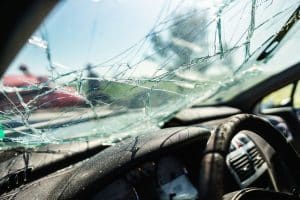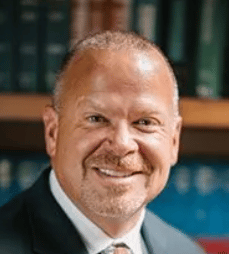 Most car accidents involve two cars that collide in head-on, broadside, or sideswipe collisions. Many multiple-car accidents involve chain reaction accidents where one car strikes a second car which strikes a third car – and so on.
Most car accidents involve two cars that collide in head-on, broadside, or sideswipe collisions. Many multiple-car accidents involve chain reaction accidents where one car strikes a second car which strikes a third car – and so on.
There are some accidents, though, that happen because one car driver’s negligence causes other vehicles to collide with each other, with roadside objects, or veer off the roadway. A few examples of these accidents – where a negligent driver doesn’t strike any vehicle – include the following:
- A driver turns left in front of you. To avoid hitting that driver, you swerve to get out of the way and your car veers off the road into a ditch, swerve into another lane of travel where a different driver strikes your vehicle, or you swerve into a roadside barrier.
- A driver fails to let you merge properly, forcing you to veer into other lanes of travel.
- A driver stops suddenly due to speeding, a pothole, an animal in the road, or any other reason, forcing you to slam on your brakes or swerve. While you avoided a collision with any other cars, you and the passengers may suffer injuries as your body moves back and forth or in other directions. For example, you could suffer a whiplash injury by braking suddenly even though you didn’t collide with any other vehicles.
Can another driver be liable for a non-collision accident in or near Sevierville?
Yes. There is no law or requirement that a driver’s car has to strike your car in order for you to be allowed a claim. Essentially, you need to show the following to file a car accident claim:
- The other driver had a duty to drive safely. Every driver who operates their vehicle in Sevierville or anywhere else in Tennessee has a duty to other drivers to drive safely and prevent accidents from happening.
- The driver’s negligence caused an accident. With the help of our experienced car accident lawyers, you should be able to show how the accident occurred even though there was no impact between your car and the negligent driver’s car. We work with investigators, the police, and traffic reconstruction experts when necessary to show how the accident happened. Once we can demonstrate how the accident occurred, we can then file a claim against the responsible defendants, including a negligent driver who didn’t strike your car.
It is generally easier to prove fault when two cars collide because the location of the damage to the cars and the severity of the damage are strong indicators of how the accident happened. For example, if the front of your car is damaged and the rear of the other driver’s car is damaged, just the damage alone indicates that the other driver rear-ended your car.
On the other hand, it is more difficult to show liability with damage to your own car alone.
- The accident caused your injuries or the death of a loved one. Usually, when cars collide, the force of another vehicle striking your vehicle and the location of said strike suggests what type of injuries you may have. If a car strikes the rear of your car, you and anyone in your car will likely suffer whiplash, soft tissue injuries, and back or neck pain. If a car strikes the front of your car head-on, then it’s likely that both you and the other driver will suffer catastrophic injuries such as traumatic brain injuries, spinal cord damage, paralysis, broken bones, and other serious injuries. It is logical to expect that some head-on crashes will be deadly.
If your car collides with a third car, then we’ll work with your doctors who can verify that your injuries are consistent with the impact of two cars colliding. Please know that we can also work with your doctors to show that your injuries are consistent with striking a traffic light, a roadside barrier, any other objects on the road, a ditch, a tree, or any other object other than a car.
Doctors should be able to verify that your injuries could also be due to just stopping your car suddenly, swerving, or even turning sharply. This is because you can move about in a car even if there isn’t any impact. Just slamming on the brakes could cause your head to strike the dashboard, causing head injuries, dental injuries, and other trauma.
Practical considerations when there is an accident but no impact with the responsible driver
Even if you can show clearly that another driver caused your injuries (even though that driver did not strike your car), you need to be able to do one of the following two things to file a claim.
- You need to identify the responsible driver. If there is no impact, the negligent driver may just continue to drive while your car is undrivable and you’re in pain. Skilled Sevierville car accident lawyers work with investigators to question any witnesses, speak with the police who may have conducted their own investigation, and speak with any businesses or residences nearby to see if they have any videos or photographs of the accident.
- You need to have uninsured/underinsured (UM/UIM) coverage. If another driver is responsible for your injuries but that driver cannot be identified, then you can file a personal injury or wrongful death claim with your UM/UIM carrier if you (or your loved one) have UM/UIM coverage. In UM/UIM cases, however, the accident must be witnessed by a non-interested party in order to prove that the accident occurred when no damage occurred to the other vehicle.
Many car accidents involve unusual situations. At Delius & McKenzie, PLLC, our Sevierville car accident lawyers have the experience and resources to handle any type of car accident case – including cases where a negligent driver didn’t actually collide with your car. To discuss your rights and how to hold other drivers accountable for your injuries, please call us or complete our contact form to schedule a free consultation. We are tireless advocates for car accident victims and families in Sevierville, Seymour, Gatlinburg, Pigeon Forge, and the surrounding Tennessee areas.

Attorney Bryan E. Delius was born and raised in Sevier County, TN. He founded Delius & McKenzie more than 20 years ago, after receiving his JD from the University of Tennessee at Knoxville. He is admitted in Tennessee and in several federal court systems. Learn more about Bryan E. Delius.




